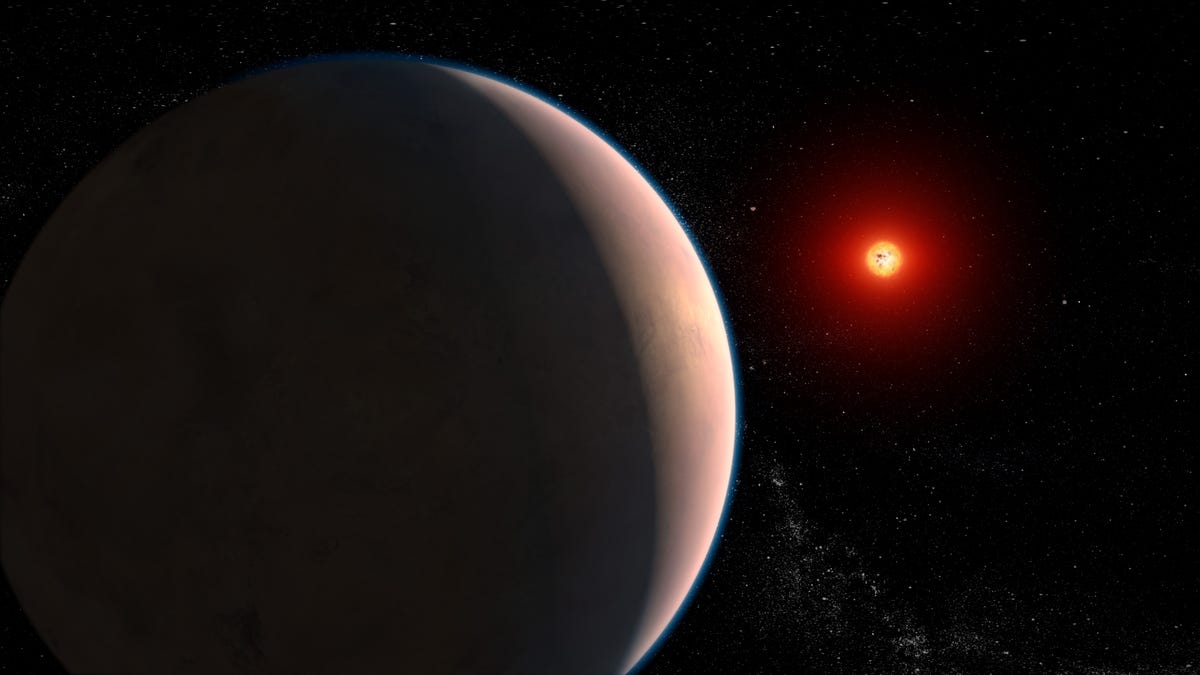
The Webb Space Telescope recently trained its perceptive gaze on a rocky exoplanet about 26 light-years from Earth and found that it appears to have water vapor in its atmosphere—a shock, given its extreme heat and its proximity to its host star.
The world—named GJ 486 b—is about 2.8 times the mass of Earth but only 30% larger, meaning it has a stronger gravitational pull than our own planet. Discovered in 2021, GJ 486 b has a surface temperature of about 800 degrees Fahrenheit and whips around its host star, a red dwarf, every 1.5 Earth days. Red dwarfs are some of the dimmest, coolest stars; some of them will be the last objects shining in the universe.
Advertisement
The stars tend to shed lots of ultraviolet and X-ray radiation, which can make it difficult for closely orbiting worlds to sustain their atmospheres. (We shouldn’t take our modern atmosphere for granted; Earth’s early atmosphere was more akin to Venus’, while Mars has lost most of its once-hydrogen-rich atmosphere.)
While GJ 486 b is too close to its star to be in the habitable zone, the Goldilocks region where liquid water could persist on a body’s surface, data from Webb’s Near-Infrared Spectrograph (NIRSpec) suggests that water vapor exists on the exoplanet. In other words, despite its superheated surface, the rocky exoplanet might have an atmosphere, which would be a shock.
Advertisement
“Water vapor in an atmosphere on a hot rocky planet would represent a major breakthrough for exoplanet science. But we must be careful and make sure that the star is not the culprit,” said Kevin Stevenson, a planetary scientist at Johns Hopkins University and the principal investigator of the project, in a Space Telescope Science Institute release.
Stevenson’s research project focuses on the number and types of atmospheres of exoplanets orbiting red dwarfs and is named for a Jordin Sparks song (I think you can guess which one.) The team’s recent work is set to publish in The Astrophysical Journal Letters.
Advertisement
It may sound counterintuitive for water to be associated with a star, a huge, roiling gaseous sphere fueled by nuclear fusion. But red dwarfs can get so cool that water vapor can concentrate in their photosphere. These so-called “starspots” can be a red herring for those hunting water in the cosmos.
“We didn’t observe evidence of the planet crossing any starspots during the transits. But that doesn’t mean that there aren’t spots elsewhere on the star. And that’s exactly the physical scenario that would imprint this water signal into the data and could wind up looking like a planetary atmosphere,” said Ryan MacDonald, an astrophysicist at the University of Michigan and a co-author of the research, in the STScI release.
Advertisement
More observations could clarify where this aqueous signal is coming from. Plans to use Webb’s Mid-InfraRed Instrument (MIRI) to look at GJ 486 b’s day side may reveal if there is an atmosphere circulating heat from the tidally locked world’s day side to its night side.
Should Webb pin down the source of water signal, it’ll be another feather in the cap of the space observatory. Webb has found worlds with silty atmospheres, noxious atmospheres, and of course worlds lacking an atmosphere altogether. In other words, it’s completely within the realm of possibility that Webb is the first telescope to spot a rocky world ensconced in water vapor.
Advertisement
More: Webb Telescope Reveals Nearby Exoplanet Has No Atmosphere
Services Marketplace – Listings, Bookings & Reviews